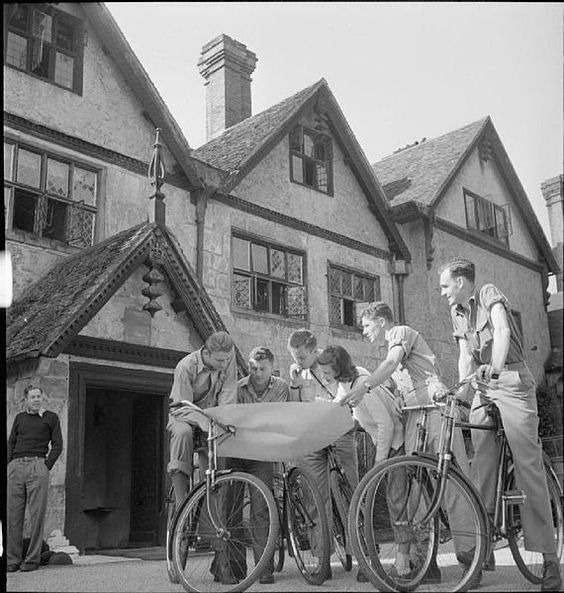|
A good bit of the screen-time in Episode 6 of "Masters of the Air" is spent with Rosie Rosenthal and his crew at a "flak house" in southern England. Like the hero in my novel "Courage to be Counted" (Jack Nielsen), Captain Rosenthal is not at all happy about being taken out of action. He too doesn't recognize how much he needs a psychological and physical respite from the horrors of war. Owners of large country estates in Britain offered their properties to serve as rest-and-recuperation homes, dubbed "flak houses" by the airmen. While the estate staff (cooks, laundry, grounds maintenance) were British, Red Cross Girls were in charge of creating and running the daily recreation opportunities. The women we saw riding bicycles with a group of men as Rosie and his crew arrived at Coombe House were likely American Red Cross Girls -- at the flak houses they frequently wore civilian attire as the goal was to help the men put the war out of their mind.  The real Coombe House is located on a 50-acre estate at Shaftesbury in the Dorset countryside. It was a hotel when it was converted to USAAF Station 523 and open as a recuperation facility for USAAF officers in September 1943. In late 1945, it converted to a Catholic independent day and boarding school for girls, St. Mary's School, and operated as such until it closed due to financial difficulties in June 2020.  In his chronicle "Flak Houses Then and Now: The Story of American Rest Homes in England during WWII," Edward Hohman notes that fliers who spent time at Coombe House recall the bar was situated below the grand ballroom and that the men wrote their names and bomb group number on the walls and ceiling. Unfortunately, unlike The Eagle, a historic bar in Cambridge which still sports similar grafitti as pictured here (photo from own visit to The Eagle as part of the National WW2 Museum's "Masters of the Air" tour led by Dr. Miller), the room was redecorated at some point during its time as a girls school. Hohman also notes that Coombe House was one of the flak houses where 8th Air Force psychiatric consultants studied the results of the flak house program.  Evening Croquet at Stanbridge Earls, Romsey, Hampshire, (photo credit: Imperial War Museum, UK) Evening Croquet at Stanbridge Earls, Romsey, Hampshire, (photo credit: Imperial War Museum, UK) "Flak houses" were intended to give battle-weary "flak-happy" airmen a place to spend time in healthy, outdoor recreation, such as riding, hunting, golf, tennis, croquet and the like (or puzzles, games, reading on rainy days). The objective of 8th Air Force commanding officers was to remove the airman from his base where he might often experience unrelenting psychological stress on some level -- even on days when an airman wasn't himself flying a mission, he might be worrying about a buddy who was or stressed out by the knowledge that today might be the last day he had.  Rest Home for Navy airmen, Glenn Innis, Auckland, New Zealand (1944) (photo credit: US National Archives) Rest Home for Navy airmen, Glenn Innis, Auckland, New Zealand (1944) (photo credit: US National Archives) The military and the Red Cross coordinated operation of "flak houses" in all theaters of the war. In the Pacific, men who'd seen heavy combat in the skies in the various island campaigns would be sent to a "flak house" somewhere along the Gold Coast of Australia or in New Zealand, often for a fairly extended stay due to the distances involved. In India, men might be sent to a British planter's estate or a Maharajah's estate for hunting wild game and other outdoorsy pursuits. In Britain, the American Red Cross managed up to 20 different properties at the height of the war, and reports indicate they hosted up to 900 crewmen per week, with 87,000 airmen rotating through some time at one of the "flak houses." These properties were devoted to either officers or enlisted men -- rest time at a "flak house" was one of the few instances where a crew would be split up by rank.
The Red Cross operations in WW2 were enormous, as they staffed thousands of recreation clubs, rest & recuperation centers (known in the ETO as "flak houses"), clubmobiles, trainmobiles, and snack centers all over the world. Though the women deployed overseas with the Red Cross served 2 full years (and many voluntarily stayed beyond those 2 years), personnel management was still daunting as ARC policy was to rotate women to different locations and different service responsibilities fairly frequently (which is a reality I've tried hard to convey in my novels).
0 Comments
Leave a Reply. |
AuthorI'm the author of historical romances set during WWII. Archives
February 2024
Categories
All
|

 RSS Feed
RSS Feed